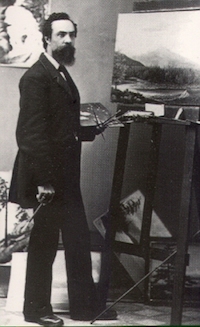Grafton Tyler Brown was a cartographer, lithographer, and painter, widely considered the first professional African American artist in California. Born in Harrisburg, Pennsylvania in 1841, Brown learned lithography in Philadelphia and then became part of a cohort of African Americans who sought better economic and social opportunities in the West during the 1850s.
Brown migrated to San Francisco in the mid-1850s, where he found work as a lithographer at Kuchel and Dresel. He bought the business in 1867 and renamed it G.T. Brown & Co., continuing his efforts to document the gold rush towns and other Bay Area settlements. Brown sold his business in 1872 in order to devote his time to traveling and painting. In 1882, Brown settled in Victoria, British Columbia, where he opened a studio. During Brown’s travels throughout the Pacific Northwest, his work transformed from concentrating on commercial and expansionist aims, to focusing on the loss of open lands and the need to preserve them. In 1886 Brown moved to Portland, Oregon where he belonged to the Portland Art Society and opened up his own studio. He left Portland for Helena, Montana in 1890. While in Helena Brown continued his work and produced a map of Yellowstone Park which was published in 1894. By that point, however, Brown had moved on. He arrived in St. Paul, Minnesota in 1892 to begin work as a draughtsman for the U.S. Army Engineer’s Office. Brown spent the rest of his life in the Minnesota city and died there in 1918.
Brown’s maps, prints, and paintings are housed in archives in Victoria, British Columbia, San Francisco, California, and Tacoma, Washington. Major exhibitions of his work in Los Angeles, Oakland, and Tacoma demonstrate Brown’s significant contribution to the settlement of the West as well as reflecting the beauty and diversity of the Pacific Northwest.

